Understanding precision agriculture
SOIL TYPE MAPPING
THIS ARTICLE IS the fifth in a series intended to introduce and explain the concept of management zones, to provide a process to define, delineate, and characterize management zones, and to outline the kinds of data and computer tools needed to be successful (go to www.gfo.ca/research/ precisionag to read previous articles you may have missed).
Detailed soil maps of soil types or soil properties are an essential component for the development and use of management zones to make decisions regarding the variable application of crop inputs such as nutrients, pesticides, seeding rates or varieties. In previous articles we discussed two other components of management zones: yield and landscape maps. This article will briefly discuss the process of creating detailed soil type maps by using predictive digital soil mapping (PDSM) methodologies. Detailed soil maps can be included in the process of creating, delineating, and characterizing management zones or they may be used on their own for making recommendation maps. Although the yield index map is the primary factor in defining a management zone, it is equally as important to include a soil component. The reason for including a soil component as part of management zone creation is to build our understanding of the influence that soil related yield limiting and non-limiting factors have on the productivity of a zone.
The current soil maps provided by the province of Ontario are not appropriate for use in precision farming. These maps were published at several scales (see Table 1) to meet the needs for soils inventory and land use planning at a county, regional or provincial scale.
At these scales, it is not possible to provide detailed soil information at the within field scale required for precision agriculture. This is because the area on the ground represented by the minimum size map delineation (MSD), which is fixed at 0.5 cm2, is controlled by the scale of the map. The dimensions and the on the ground areas that can be represented on soils maps at various scales are shown in Table 1. As can be seen in Table 1, the MSD can actually be larger than a single field. If we apply the principle of the minimum size delineation to precision agriculture and match it to an eight row corn planter width, for example, then the dimensions of the MSD would be 6×6 meters which equates approximately to a mapping scale of 1:860.
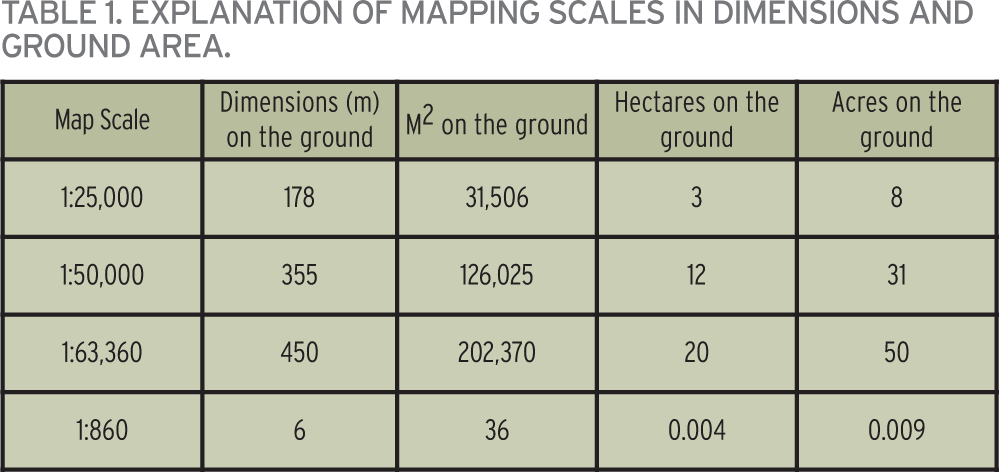
In Southern Ontario, several hundred soil types have been recognized and mapped. A soil type name taken from the soil map has two components. The first component is the soil series and the second is the soil texture of the plow layer. An example of a soil type is a Bookton (series name) fine sandy loam (surface texture) (Figure 1). A soil series is unique in that it has developed on a specific parent material(s), has a specific sequence of soil horizons with specific ranges of soil colours, thicknesses, soil structure, texture, pH, and other properties.
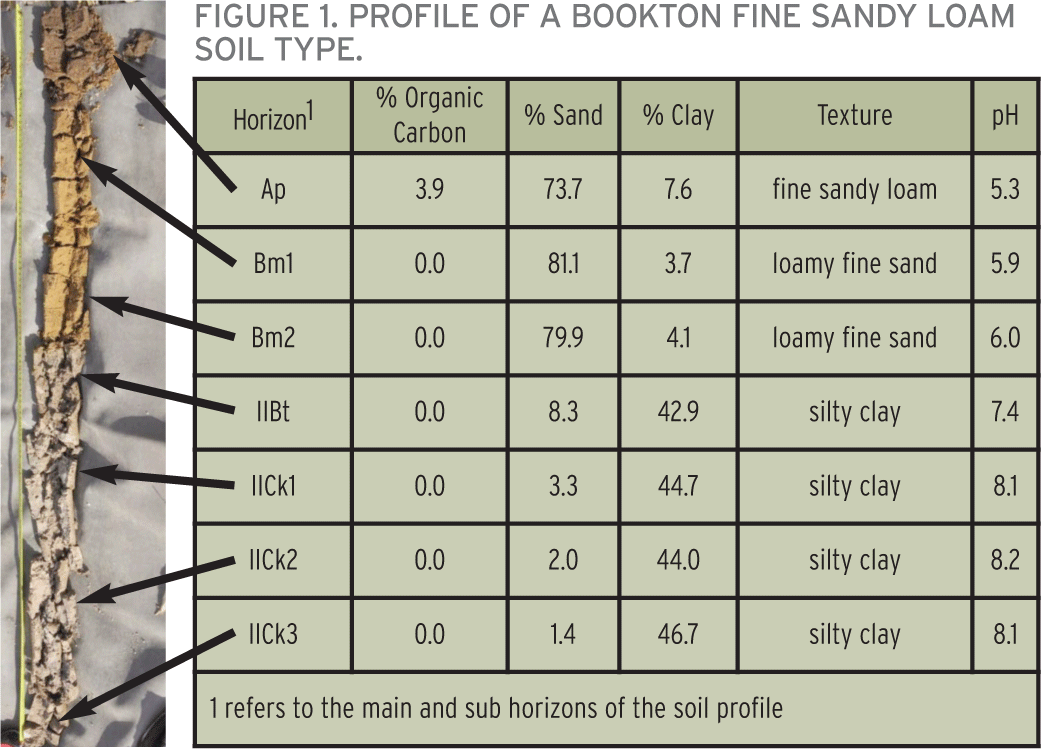
To identify a soil type at a point in the landscape it is necessary to extract a complete soil profile with an auger or a soil coring machine. It is advisable to engage a consulting pedologist who has knowledge of and experience with describing and naming Ontario soil types. Detailed soil type profile descriptions for Ontario soils are provided in the Ontario County Soil Reports. Access to these reports is provided at this website: http://sis.agr.gc.ca/ cansis/ publications/surveys/on/index.html. Check the soil map to find out what kinds of soil types may be found in your field. Refer to the detailed soil profile descriptions for the naming of soil types. Digital versions of the soil maps can now be found at: www.ontario.ca/agmaps — Agricultural Information Atlas.
PREDICTIVE DIGITAL SOIL MAPPING (PDSM)
Over the last two decades or so, PDSM and soil sensing technologies have emerged which will increase the accuracy, scale, and speed of soil mapping. PDSM is an ideal method for creating very detailed soil maps for individual farm fields. It is based on the idea that if the relationship is known between a soil and its environment then the occurrence of that soil can be predicted in other areas of a field having the same environment. PDSM soil maps have a significantly higher spatial resolution and better represent the actual distribution of various soils, especially for precision agriculture.
PDSM requires three datasets:
1. a digital elevation model (DEM) (as discussed in article 2);
2. an electrical conductivity (EC) or electromagnetic (EM) map;
3. the location and identification of the soil types in your field.
EC or EM data layers are collected with a VerisTM or a DualEMTM sensor. The RTK-GPS elevation data can be collected at planting or harvest. The PDSM software will use these layers and then select one or more individual raster cells (which can be grouped, smoothed, and changed to regions or polygons) which are highly representative of each soil forming environment class. These cells are used to direct soil sampling/coring to identify soil types and each sampling site location is logged by its GPS coordinates. It is important to note that these cores are not the typical narrow 6 to 12 inch core used in soil nutrient sampling. These cores are up to 4 feet deep and can be 2-4 inches in diameter. This information serves as input for PDSM to create the soil type map. The soil name is assigned to other areas in the field with a soil forming environment that is similar to the one where the sample was taken from. The mapping software predicts one or more soil types for each raster cell and the soil type with the highest score is assigned to create the final PDSM map.
The conventional soil map unit polygons shown in Figure 2 were taken from the Soils of the Regional Municipality of Haldimand- Norfolk (1984) at a scale of 1:25,000. Seven soil types were mapped in this field and each soil map unit contains a mix of two soils which occur in either a 50:50 or a 70:30 per cent split. This map indicates which part(s) of the field the soils may be expected to be found. It does not show where the soil types actually occur on the landscape.
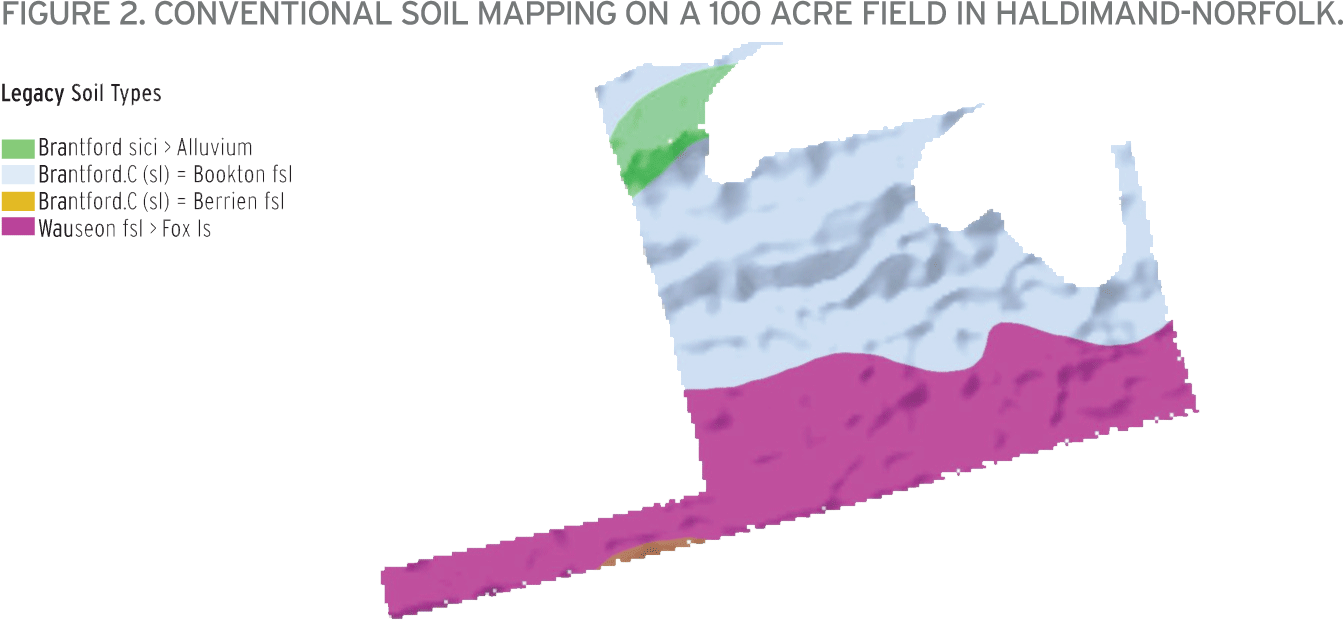
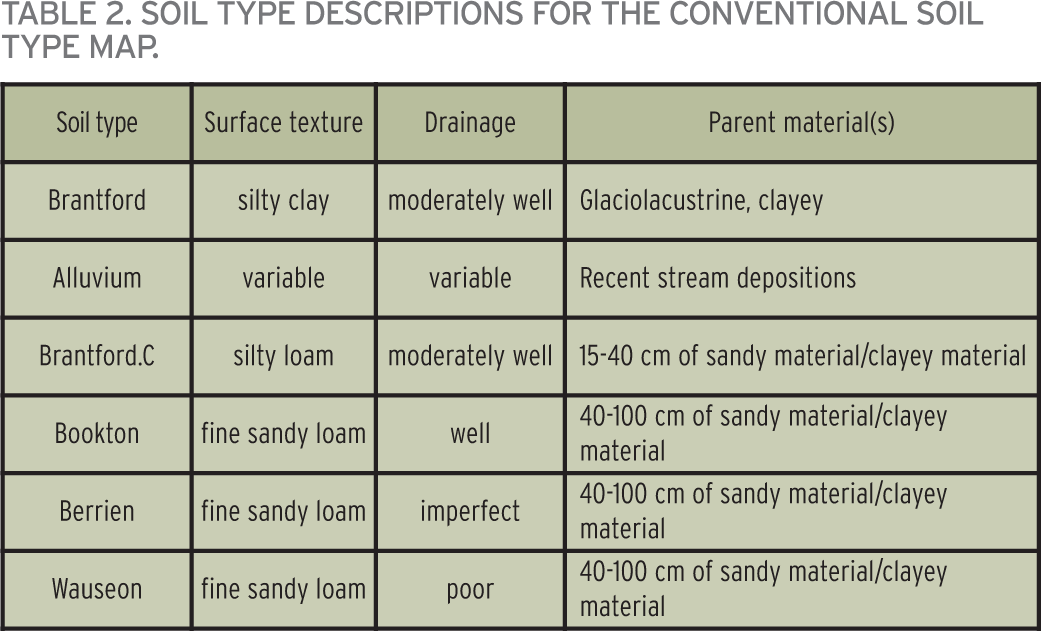
Figure 3 is a soil type map using the PDSM approach. Fifteen soil environments were identified in this field. Approximately 40 soil sampling/coring points were made in this field.
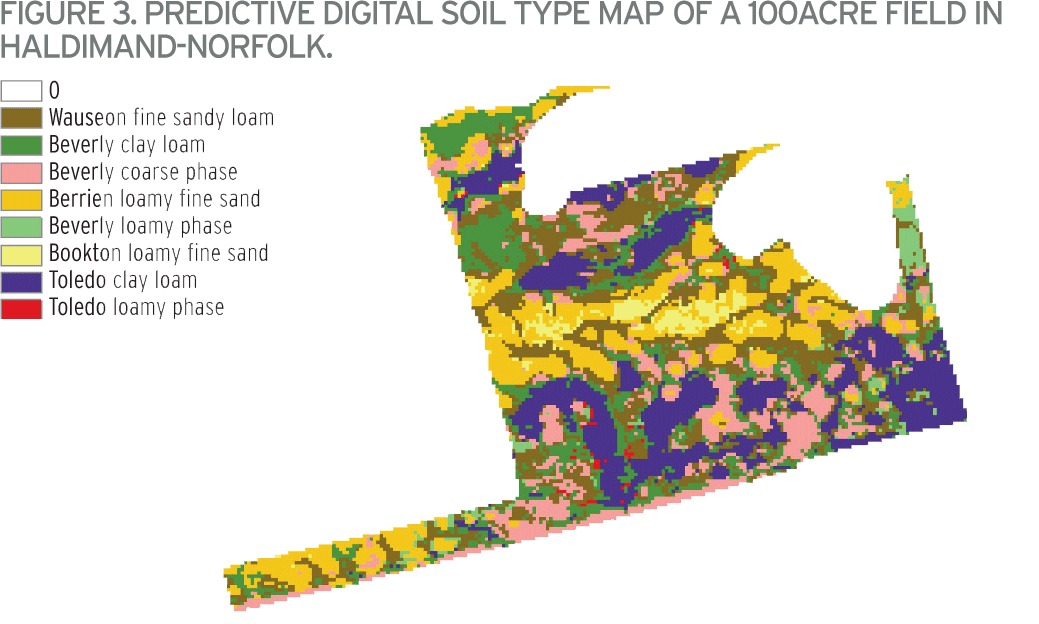
This map differs from the previous map in several ways:
1. the soil types are shown where they occur in the landscape;
2. four of the soils (Brantford sicl, Brantford.C, Fox ls and Alluvium) identified on the conventional soil map were not found;
3. five soil types (Beverly cl, Toledo.C, Beverly.L, Toledo cl and the Toledo.L) were added to the list of soils mapped in this field;
4. the surface textures of Bookton and Berrien soil types were found to be slightly different (fsl vs. lfs).
The agricultural soil landscape in Ontario is very complex, and the historical soil survey reports and map information are valuable for soil type information in a specific region. At a minimum, farmers can get a sense of what to expect for a soil series in their neighbourhood. In precision agriculture, leveraging EC/EM and topographic datasets in a PDSM requires soil science knowledge and pedology experience. This may be viewed as an extravagant investment on a per field basis for precision agriculture, but this type of data layer only needs to be done once. PDSM soil maps have a significantly higher spatial resolution and better represent the actual distribution of soil types in a field for precision agriculture strategies. Each soil type has different properties that relate to how the crop performs. Understanding the physical soil characteristics of each management zone is necessary to be able to fully utilize the multi-year yield data to its full potential. It is also an excellent way to ensure the management zones you have created for a specific farm field are stable and reliable for variable rate fertilizer, seed, and perhaps hybrid or variety strategies in the future.
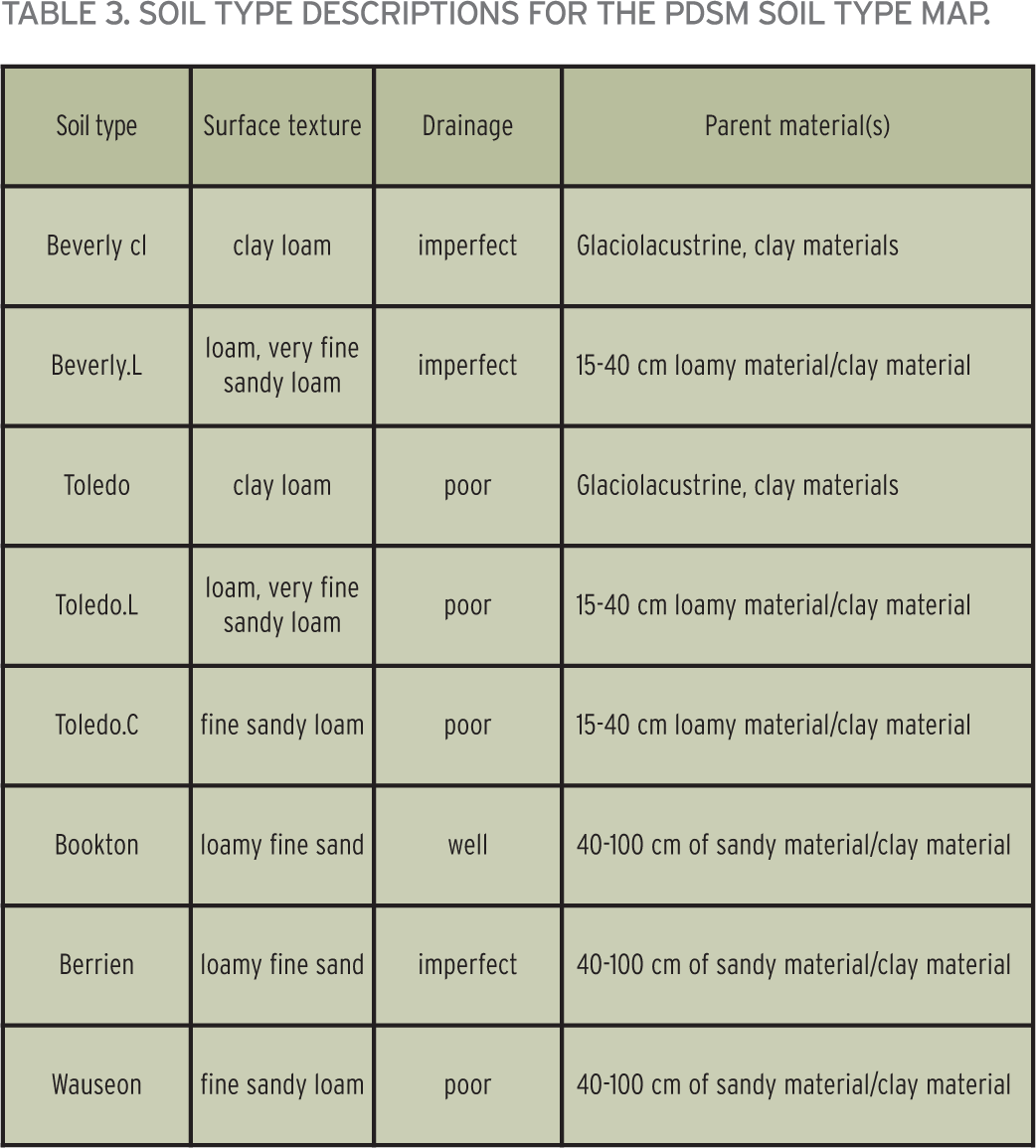
RESEARCH UPDATE
Researchers have been busy on the project ‘Precision Agriculture Advancement in Ontario’ throughout the winter and spring. The Niagara College team led by Dr. Mike Duncan has developed a web portal that acts as a data repository and also hosts a transparent set of tools for manipulating field data with explanations on how the tools work and how to best use them.
Researchers, farmers, and crop consultants on the project have collected many layers of data from the farm fields, including elevation, soil texture, soil fertility, organic matter, cation exchange capacity, and more. Using the data and the portal, digital maps of the 20 farm fields involved in the study were analyzed to define management zones. In spring of 2015, corn, soybean, and wheat fields had either a variable rate population or variable rate Nitrogen strategy implemented. Prescription maps were implemented by project industry partners and the cooperators equipment. There were also validation plots included in the variable rate population or fertilizer prescription maps. The validation plots were automatically implemented at planting or application time and will act as a “control” that will be used to confirm if the planting or fertilizer prescriptions were optimal.
This project was funded in part through Growing Forward 2, a federal-provincial-territorial initiative. The Agricultural Adaptation Council assists in the delivery of Growing Forward 2 in Ontario. •





















